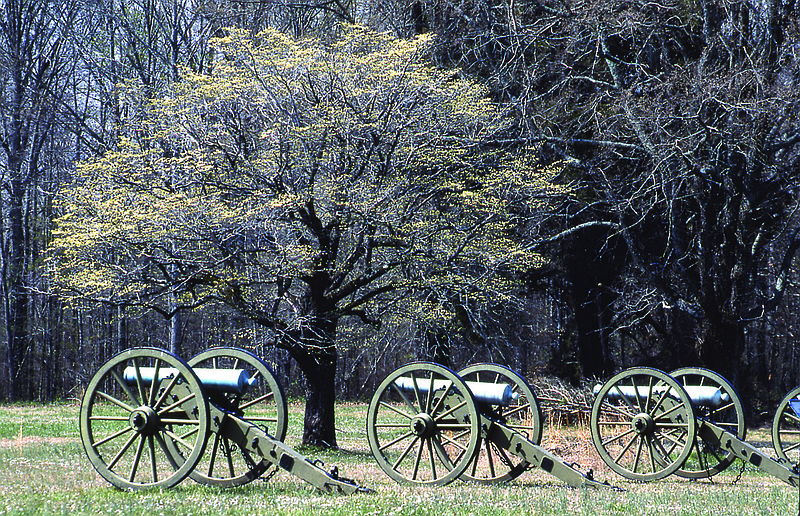With the 150th anniversary of the Civil War's initial battles approaching, there is no better time to build travel around history.
Regional maps and histories of the Civil War share the same names: Missionary Ridge, Lookout Mountain, Stones River, Resaca, Tunnel Hill.
Georgia boasts the nation's first and oldest national military park at the Chickamauga Battlefield. The Civil War Trails program has installed more than 1,000 interpretive markers at Civil War sites in Tennessee and North Carolina, and Alabama is tied to the early days of the Confederacy.
TENNESSEE
Invade the Volunteer State.
The Union did it.
• Fort Donelson National Battlefield, on the Cumberland River between Nashville and Paducah, Ky., on Feb. 16, 1862 became the first decisive Union move into Tennessee.
The Union victory elated the North and stunned the South. Within days of the surrender, Clarksville and Nashville would fall into Union hands.
• Stones River National Battlefield near Murfreesboro was the site of a fierce battle from Dec. 31, 1862 until Jan. 2, 1863. More than 81,000 soldiers fought in the fields and cedar glades. There were 23,000 casualties.
The Confederates withdrew, allowing the Union Army to control Middle Tennessee. The battle set the stage for the Union advance to Chattanooga.
• Shiloh National Military Park near Pittsburg Landing on the Tennessee River just three months later became the bloodiest military engagement in American history to that point. On April 6, nearly 24,000 casualties in a field of 103,000 soldiers became a grim harbinger for the war's tragedy.
Sources: National Park Service, www.civilwartraveler.com/events
GEORGIA
The key to the war was the railroad.
• Chickamauga & Chattanooga National Military Park includes several sites that include battlefields in Chickamauga, Missionary Ridge, Signal Point, Lookout Point and Cravens House on Lookout Mountain.
The National Park Service has created a 37-stop tour with interpretive signs that describe the chess game played by Union commander Gen. William Rosecrans and Confederate Gen. Braxton Bragg to control Chattanooga and the railroad.
When the Union prevailed at the end of 1863, Atlanta became the next obvious target. When Atlanta fell, Gen. William Tecumseh Sherman began his March to the Sea.
• Kennesaw National Military Park near Marietta was where the battle for Atlanta began on a too-hot June 27, 1864. Today, Kennesaw Mountain National Battlefield preserves the remnants of that fight and offers miles of hiking trails where history peeks out at every turn.
Sources: National Park Service, www.civilwartraveler.com/events
ALABAMA
The heart of Dixie fueled the Confederacy.
• Stevenson Railroad Depot Museum in Stevenson, Ala., commemorates the town's history as a busy and strategic junction of Memphis and Charleston Railroad and the Nashville and Chattanooga Railroad. It also was here that a pontoon bridge allowed thousands of Union soldiers to advance into North Georgia during the Chattanooga campaign.
Another Stevenson site, Fort Harker, was built by Union soldiers and freed slaves in 1862. It was briefly used as headquarters for Union commander Gen. Rosecrans during the Chattanooga campaign.
• Bridgeport Depot Museum in Bridgeport, Ala., tells a similar history. Important bridges across the Tennessee River at the aptly named town saw activity throughout the war.
• The Blue and Gray: North Alabama Civil War Museum in Decatur, Ala., and a Decatur nine-stop walking tour, including surviving buildings, tell of Confederate Gen. John Bell Hood's unsuccessful efforts to disrupt Sherman's supply lines and march to the sea. The 5,000-square-foot museum is billed as the world's largest private collection of Civil War artifacts.
Source: www.civilwartraveler.com/events
NORTH CAROLINA
Divided loyalites and a final surrender.
• Dixie Hall, a site near the Macon County Courthouse, was where one of the last surrenders east of the Mississippi occurred.
• Confederate Col. William H. Thomas organized Thomas' Legion of Cherokee Indians and mountaineers in North Carolina in September 1862. Several locals, both white and Indian, joined the unit, which fought in Tennessee, Kentucky, Virginia and North Carolina.
Thomas eventually recruited more than 2,000 men, among them about 400 Cherokee. On May 14, 1865, part of the famed Thomas' Legion was issued parole papers.
Source: http: www.civilwartraveler.com/events
-- Compiled by staff writer Pam Sohn
